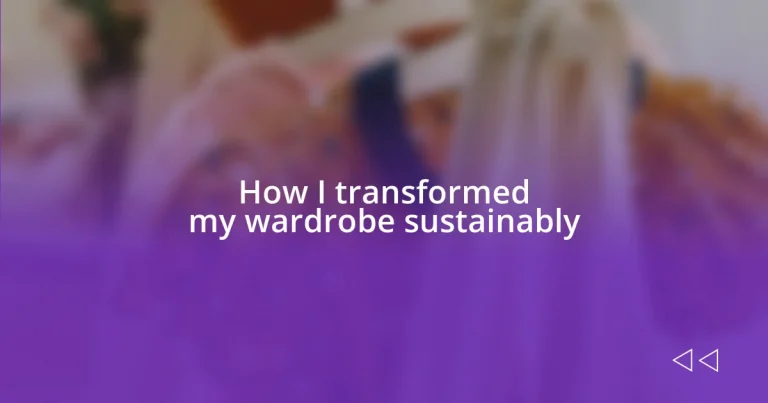Key takeaways:
- Embrace sustainable fashion by prioritizing eco-friendly brands, second-hand shopping, and mindful purchasing to reflect personal values.
- Assess your wardrobe to identify items that you truly wear and cherish, leading to more intentional choices and the donation of unused garments.
- Incorporate practices like upcycling and regular maintenance to extend the life of clothing, reinforcing a commitment to sustainability and creativity.
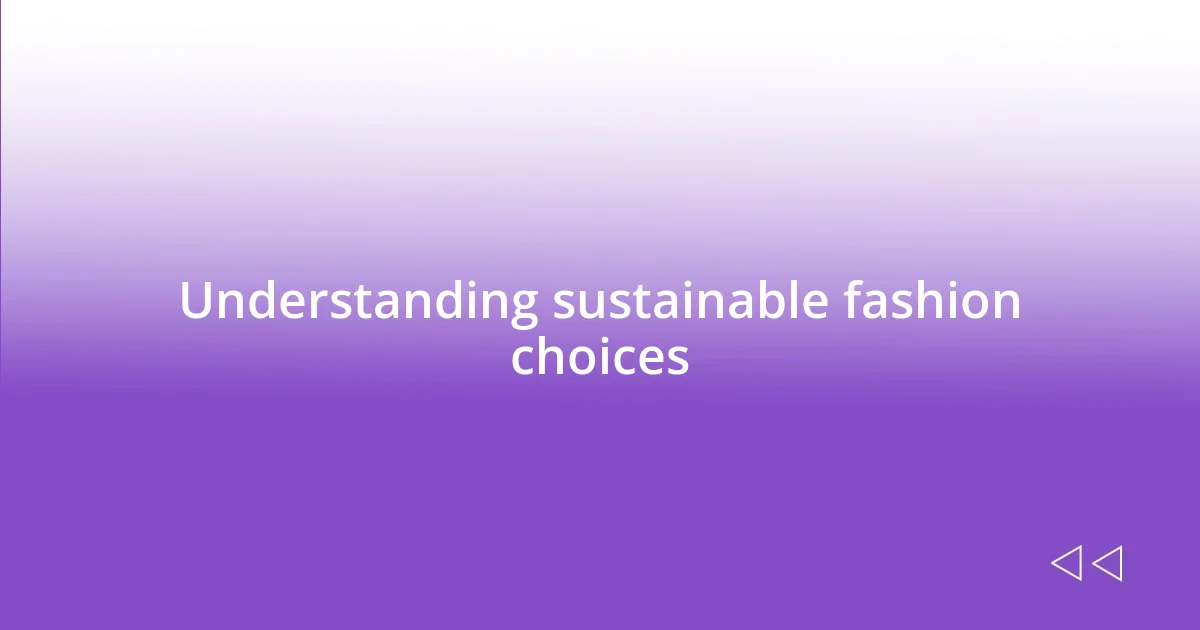
Understanding sustainable fashion choices
When I first delved into sustainable fashion, I was struck by the sheer volume of choices available to us. It’s not just about chic outfits—it’s about understanding the impact of each piece I add to my closet. Have you ever considered where those fabrics come from and the journey they take? I certainly hadn’t, until I began sourcing materials from brands that prioritize eco-friendly practices.
Trying to align my wardrobe with sustainable values felt daunting at first. I remember standing in front of my closet, overwhelmed by the countless fast fashion options I had once cherished. But then, I realized that every small choice counts; opting for second-hand stores or supporting local artisans became my new norm. Isn’t it empowering to know that our purchases can reflect our values, transforming not just our style but also the world around us?
The emotional weight of my fashion choices started to sink in deeply. It’s like the moment you discover a favorite thrift store and score a vintage jacket—it feels personal, right? Each sustainable choice becomes a part of a larger narrative in my life, where I consciously decide to embrace quality over quantity. Wouldn’t you agree that there’s something special about wearing clothes that carry a story?

Assessing your current wardrobe
Taking a close look at my wardrobe was a revelation. I couldn’t believe how many items I had that I never wore, merely taking up space. It struck me that each piece represents a choice I made, sometimes impulsively. I remember pulling out a pair of neon green heels that I wore once for a party; they still looked stylish but never quite fit my everyday style. Assessing your current wardrobe urges you to confront not just what you own but also the reasons behind each purchase.
To help in this assessment, consider these key points:
- Frequency of Wear: How often do you wear each item? If it’s less than once every few months, it might be time to reconsider its place in your closet.
- Emotional Connection: Do you feel excited or indifferent when you see an item? Clothes that spark joy often have a meaningful story or memory attached.
- Sustainability Factors: How eco-friendly is the item? Material and production methods matter—ask yourself if it aligns with your sustainable goals.
- Versatility: Can you style it in multiple ways? Pieces that work for various occasions often yield more value.
- Condition: Is it damaged or outdated? Clothing that’s beyond repair might be better off as a memory rather than in your closet.
By evaluating these aspects, I found freedom in my choices. I packed away items for donation, feeling lighter and more intentional about the pieces I kept. It felt like a cathartic cleanse, and I was excited to find new staples that truly reflected who I am today.
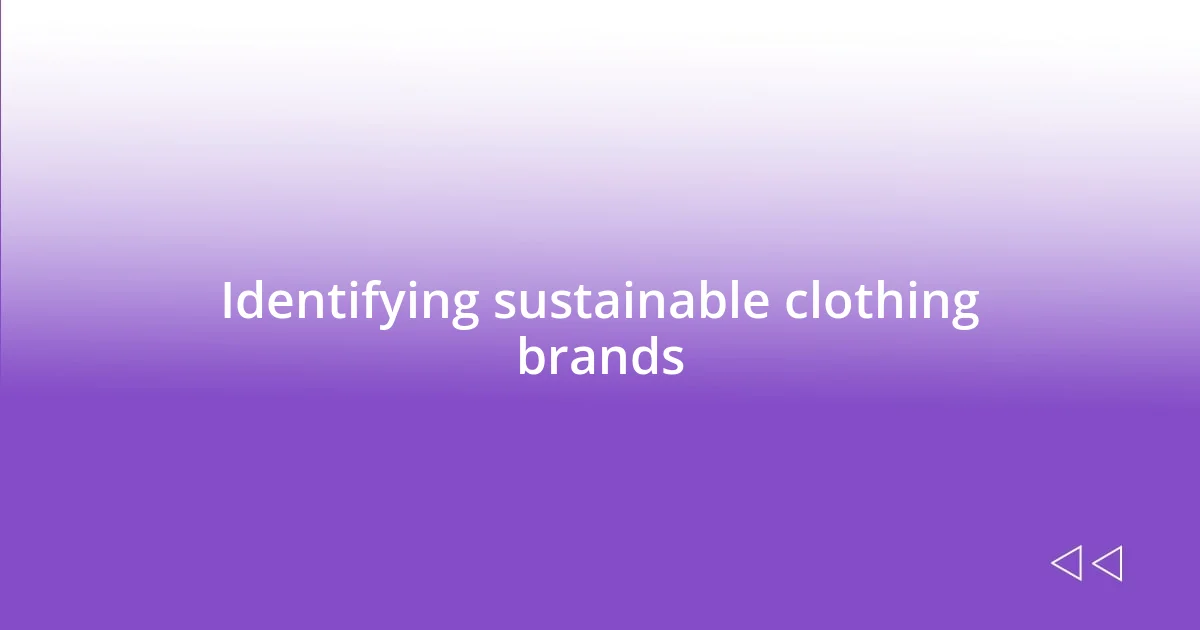
Identifying sustainable clothing brands
Identifying sustainable clothing brands can be an enlightening journey. For me, it started with research and a bit of detective work. I remember hopping online, scanning through countless websites, and realizing that not all brands are created equal. Finding those that prioritize ethical production, fair wages, and eco-friendly materials made me feel like I was unearthing hidden gems rather than just buying clothes. It required patience, but the satisfaction of discovering brands that resonate with my values was well worth it.
I’ve learned to look for certain key indicators when evaluating a brand’s sustainability claims. For example, certifications like GOTS (Global Organic Textile Standard) and Fair Trade can offer reassurance that a brand meets specific ethical standards. On the other hand, I always ask myself if the brand is transparent about its supply chain. Does it disclose where their materials come from? Brands that openly share this information tend to be more trustworthy. It’s like peeling back the layers of a well-curated wardrobe to find the true story behind each piece.
As I navigated through various brands, I developed a comparison chart to help me make informed decisions. This chart not only tracked the brands I admired but also highlighted their practices. Each entry became a reflection of my journey toward sustainable choices. Ask yourself, how can you create a simple yet effective way to evaluate brands as you transition to a more eco-conscious wardrobe?
| Brand | Key Practice |
|---|---|
| Patagonia | Environmental activism and recycled materials |
| Eileen Fisher | Fair Trade and organic fibers |
| Everlane | Transparent pricing and ethical factories |
| Reformation | Eco-friendly fabrics and energy efficiency |
| People Tree | Fair Trade certified and sustainable sourcing |

Incorporating second-hand shopping
Second-hand shopping became one of my favorite avenues for transforming my wardrobe sustainably. I vividly recall stepping into my first thrift store, the smell of vintage fabric mingling with a hint of nostalgia. I felt like a treasure hunter, eagerly sifting through racks of unique pieces that told their own stories. One time, I found a beautifully tailored blazer that not only fit like a glove but also sparked an idea for a whole new outfit. That thrill of the hunt keeps me coming back for more.
Embracing second-hand shopping has also reshaped my view of fashion’s fleeting nature. Rather than feeling pressured to keep up with trends, I discovered that vintage pieces often have more character and durability. I wear a stunning skirt from the ’70s that’s held up beautifully, drawing compliments every time I put it on. This experience makes me question: Why switch out quality for quantity? The joy of finding something with history makes each addition to my wardrobe feel purposeful.
I’ve learned to explore online platforms as well, like Poshmark and Depop, which have expanded my options exponentially. I remember scrolling through endless photos and landing on a cozy knit sweater that felt like a warm hug. It wasn’t just about acquiring new clothes; it was a mindful approach to fashion that aligns with my values. Have you ever considered how much environmental impact your clothing choices have? Each second-hand item adds to a more sustainable future, and that feels pretty amazing to me.

Using a capsule wardrobe approach
Adopting a capsule wardrobe approach has truly transformed how I view my closet. When I first decided to embrace this minimalist style, I was surprised at how liberating it felt to limit my choices. I remember carefully selecting a small number of versatile pieces that I could mix and match effortlessly. Each time I put together an outfit, I felt a sense of satisfaction knowing I was maximizing my wardrobe without the chaos of excessive options.
This method not only simplified my life but also made getting dressed a more intentional experience. With the core pieces I chose, like a classic white shirt, tailored jeans, and a cozy cardigan, I created countless looks. I often find myself asking, how can a few quality items spark so much creativity? It’s fascinating to realize that style doesn’t have to stem from abundance; sometimes, the best outfits arise from restraint.
I also found that a capsule wardrobe aligned beautifully with my sustainability goals. By investing in timeless, high-quality pieces, I reduced the impulse to shop frequently, embracing the idea of purchasing less but better. Each item became a staple in its own right. I still vividly recall the feeling of slipping into my first well-made dress—it wasn’t just clothing; it was an experience, a commitment to choosing mindful fashion. What do you think? Could a capsule wardrobe be your secret to a more sustainable, stylish life?
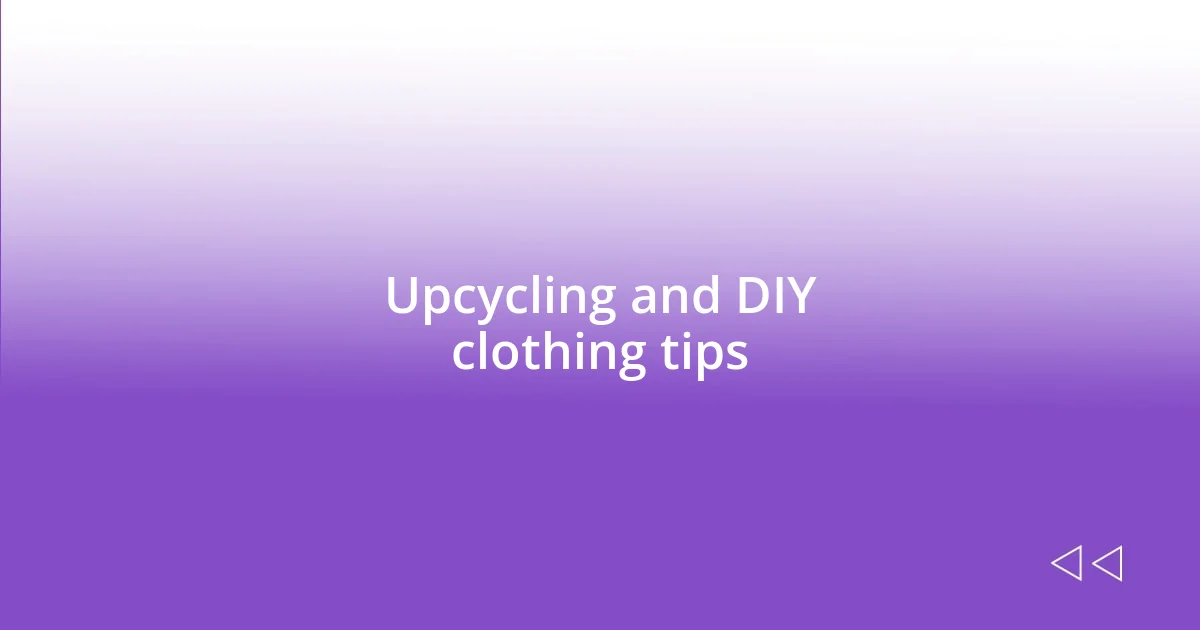
Upcycling and DIY clothing tips
Upcycling old clothes is one of the most rewarding aspects of sustainable fashion. I remember transforming a pair of jeans that had seen better days into a chic bag by simply cutting them and adding some fun patchwork. It was surprising how a little creativity could breathe new life into something destined for the trash. Have you ever looked at your clothes and wondered what else they could be?
DIY projects don’t have to be complex to be effective; sometimes, a simple hem or button change can make a world of difference. I once took a plain cotton t-shirt and used fabric paint to create a unique design that turned it into a conversation starter. It became a favorite in my wardrobe, reminding me that personal expression doesn’t always require a hefty price tag. Can you think of items in your closet that just need a little love to shine again?
Another great tip is to host an upcycling party with friends. I did this last summer, and it was such a blast to collaborate and share ideas over snacks and laughter. We exchanged techniques, like tie-dyeing or distressing denim, and ended up with a wardrobe full of fresh looks and cherished memories. What if gathering friends for a fun DIY session could spark your own upcycling journey?
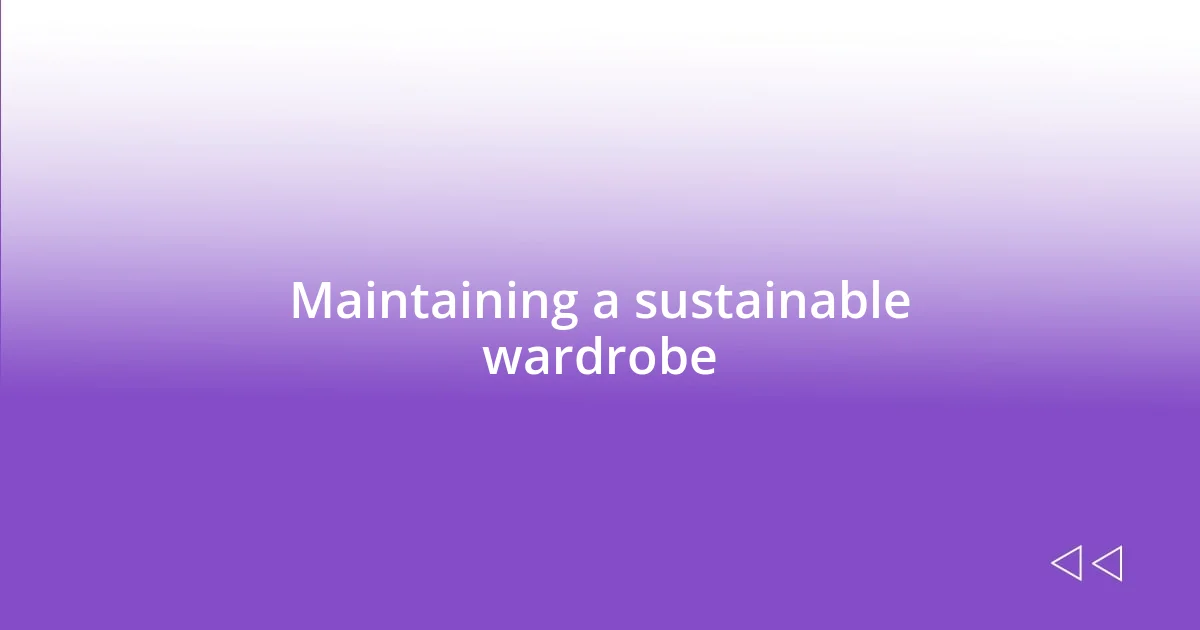
Maintaining a sustainable wardrobe
Maintaining a sustainable wardrobe goes beyond just initial choices; it’s about nurturing those pieces over time. I’ve found that regular care, such as washing clothes with cold water and air drying them, not only extends their lifespan but also reduces my environmental impact. Have you ever noticed how small habits can create significant change?
I also organize my closet seasonally, making it easy to see what I actually wear. This practice has helped me identify what I truly love and what just takes up space, allowing me to make more intentional decisions about future purchases. I vividly recall the sense of relief when I donated clothes I hadn’t worn in years; it felt like shedding a weight I didn’t realize I was carrying. Isn’t it freeing to know that every piece you own is something you genuinely cherish?
Another aspect I cherish is learning to repair rather than replace. I vividly remember the heartbreak of finding a tiny rip in my favorite sweater, but instead of tossing it out, I learned to sew. Each patch and stitch became a part of the garment’s story. Have you ever thought about the joy of turning a small mishap into a unique detail? Embracing repairs not only fosters creativity but also strengthens my connection to each piece in my wardrobe.











